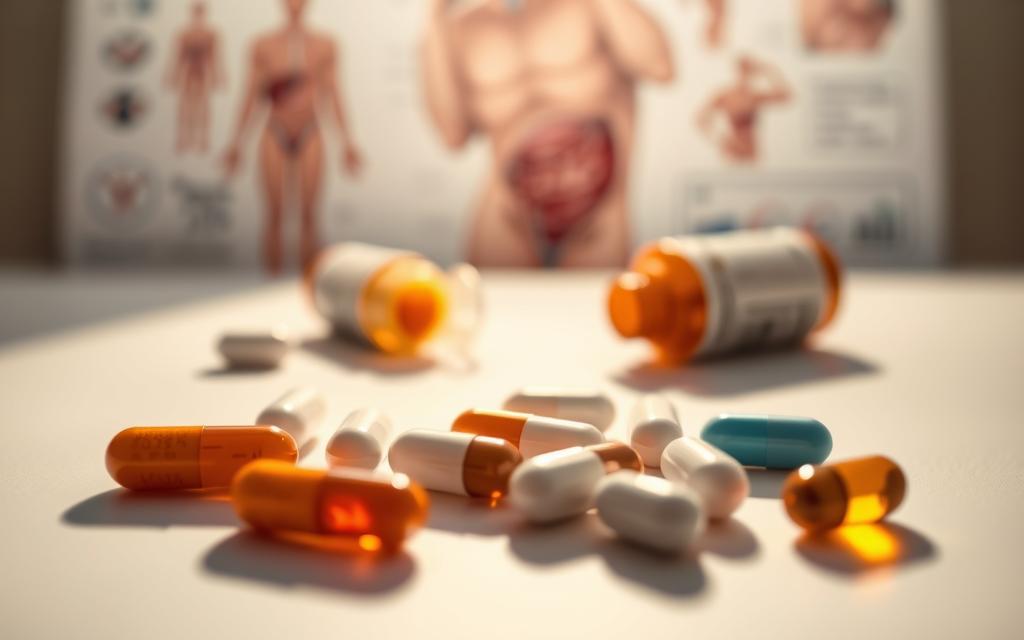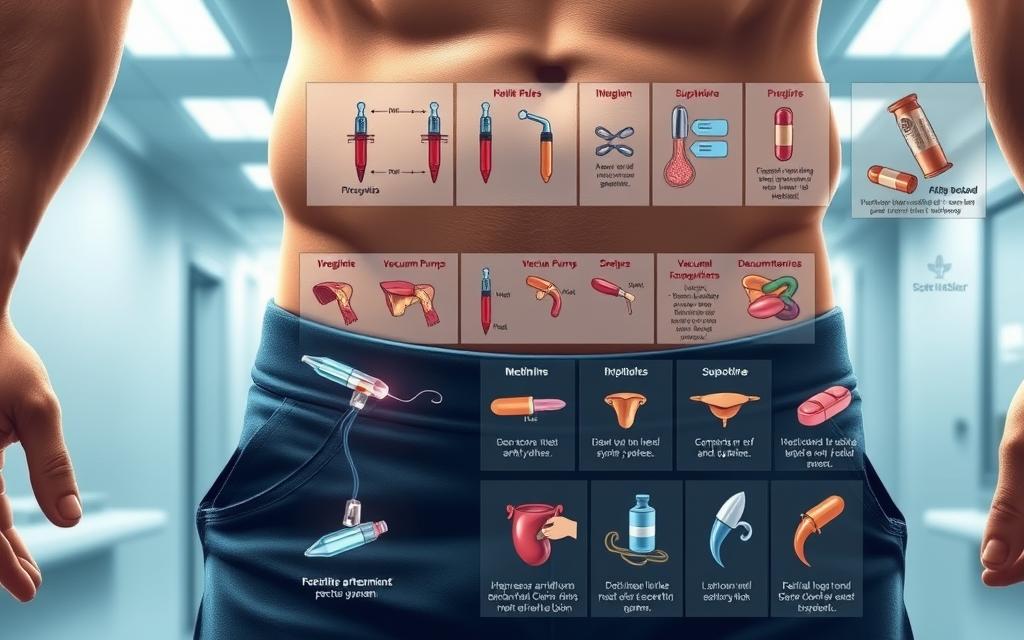Best Treatment for Erectile Dysfunction When Viagra Doesn’t Work: Effective Alternatives
Erectile dysfunction (ED) is a common condition affecting millions of men worldwide, including in the United States. While Viagra has been a widely used erectile dysfunction treatment, it doesn’t work for everyone.
For those who don’t respond to Viagra, there are other effective alternatives available. These alternatives can provide new hope for men struggling with ED.
Understanding the available options is crucial in finding the right erectile dysfunction treatment. This article will explore the various alternatives to Viagra, providing insights into their effectiveness and how they can help.
Understanding Why Viagra May Not Work
While Viagra is effective for many, there are various reasons why it may not work for some individuals with erectile dysfunction. Understanding these reasons is crucial for determining the next steps in treatment.
Common Reasons for Viagra Failure
Several factors can contribute to Viagra’s ineffectiveness. These include underlying health conditions and interactions with other medications.
Underlying Health Conditions
Certain health issues can significantly impact Viagra’s effectiveness. These conditions include:
- Diabetes: High blood sugar levels can damage blood vessels and nerves, making it harder for Viagra to work.
- Heart Disease: Conditions like atherosclerosis can restrict blood flow, reducing Viagra’s efficacy.
- Obesity: Being overweight can lead to various health problems that may affect Viagra’s performance.
As noted by a study published in the Journal of Sexual Medicine, “Men with diabetes are more likely to experience ED and may require adjusted treatment strategies.”
Medication Interactions
Some medications can interact with Viagra, reducing its effectiveness or increasing the risk of side effects. Notable examples include:
| Medication Type | Potential Interaction |
|---|---|
| Nitrates | Can cause a significant drop in blood pressure when combined with Viagra. |
| Alpha-blockers | May lead to hypotension (low blood pressure) when taken with Viagra. |
| Certain Antidepressants | Can increase the risk of side effects like priapism. |
When to Consider Alternative Treatments
If Viagra doesn’t work, it’s essential to consult a healthcare provider to discuss alternative ED treatment options. This decision is typically considered when:
- Viagra has been taken correctly and consistently without the desired effect.
- Underlying health conditions or medication interactions are identified as the cause.
“It’s crucial to work with a healthcare provider to find the most effective treatment plan, as erectile dysfunction can be a complex condition with multiple underlying causes.”
The Best Treatment for Erectile Dysfunction When Viagra Does Not Work
Viagra may not work for everyone; fortunately, there are other options for treating erectile dysfunction. When considering alternative treatments, it’s essential to understand the various options available and the factors that influence their effectiveness.
Overview of Alternative Treatment Options
Several alternatives to Viagra are available, including other PDE5 inhibitors, non-oral medications, medical devices, and advanced therapies. Other PDE5 inhibitors like Cialis and Levitra offer different profiles of action and side effects. Non-oral medications, such as alprostadil injections, provide another avenue for treatment. Medical devices, including vacuum erection devices and penile implants, offer mechanical solutions. Advanced therapies like shockwave therapy and PRP therapy are also being explored for their potential in treating ED.
Factors to Consider When Choosing Alternatives
When selecting an alternative treatment, several factors come into play. These include:
- Effectiveness Rates: Understanding how well a treatment works is crucial.
- Side Effect Profiles: Different treatments have varying side effect profiles.
- Cost and Insurance Coverage: The cost of treatment and whether it’s covered by insurance can significantly impact the choice.
Effectiveness Rates
The effectiveness of ED treatments can vary significantly from one individual to another. For instance, PDE5 inhibitors are effective in about 70-80% of men, but this can vary based on the underlying cause of ED.
Side Effect Profiles
Each treatment has its side effect profile. For example, PDE5 inhibitors can cause headaches and flushing, while alprostadil injections can cause pain at the injection site.
Cost and Insurance Coverage
The cost of ED treatments varies widely. Some treatments, like PDE5 inhibitors, are often covered by insurance, while others, such as certain advanced therapies, may not be.
By considering these factors, individuals can make informed decisions about their ED treatment, choosing the option that best suits their needs and circumstances.
Other PDE5 Inhibitors as Alternatives to Viagra
PDE5 inhibitors, including Cialis, Levitra, and Stendra, provide various options for those seeking alternatives to Viagra. These medications work similarly to Viagra by enhancing the effects of nitric oxide, a natural chemical the body produces that relaxes muscles in the penis, increasing blood flow.
Cialis (Tadalafil): The “Weekend Pill”
Cialis, known for its longer duration of action, is often referred to as the “weekend pill.” It allows for more spontaneity compared to other ED medications.
Dosage Options and Duration
Cialis is available in various dosages, including a daily low-dose option (2.5mg or 5mg) for continuous effect and higher doses (10mg or 20mg) for on-demand use, effective for up to 36 hours. This flexibility makes it a popular choice among men who prefer a longer window of efficacy.
Unique Benefits
One of the unique benefits of Cialis is its ability to treat both erectile dysfunction and symptoms of benign prostatic hyperplasia (BPH) when taken daily. This dual-action capability can simplify treatment regimens for men suffering from both conditions.
Levitra (Vardenafil): Fast-Acting Option
Levitra is another PDE5 inhibitor that is known for its fast onset of action. It is available in various strengths, including 2.5mg, 5mg, 10mg, and 20mg orodispersible tablets, offering flexibility in dosing.
Levitra’s fast-acting nature makes it an attractive option for men seeking a quick response. It is often praised for its effectiveness in men who have not responded well to other PDE5 inhibitors.
Stendra (Avanafil): Newest PDE5 Inhibitor
Stendra is one of the newest PDE5 inhibitors on the market, known for its rapid onset of action, typically within 15-30 minutes. It is available in 50mg, 100mg, and 200mg doses.
The quick action of Stendra, combined with its relatively fewer side effects, makes it an appealing choice for many men. Additionally, Stendra has been shown to have fewer interactions with other medications, enhancing its safety profile.

As highlighted by a study, “the availability of multiple PDE5 inhibitors allows for personalized treatment plans, improving the likelihood of finding an effective treatment for erectile dysfunction.”
“The choice of PDE5 inhibitor should be based on individual patient characteristics, including efficacy, safety, and patient preference.”
Non-Oral Medication Options for ED
When oral ED medications fail, it’s reassuring to know that non-oral medication options exist, offering new hope for effective treatment. For individuals struggling with erectile dysfunction, these alternatives can provide a reliable solution.
Alprostadil Injections
Alprostadil injections are a type of non-oral ED treatment that involves injecting medication directly into the penis. This method can be effective for men who have not responded to oral therapies.
Administration Technique
The administration of Alprostadil injections requires careful technique to minimize discomfort and ensure efficacy. Men are typically advised on how to self-administer the injections at home.
Effectiveness and Considerations
Alprostadil injections have been shown to be effective in inducing erections in men with ED. However, potential side effects, such as pain or fibrosis, need to be considered.
Alprostadil Urethral Suppository (MUSE)
MUSE is another non-oral option that involves inserting a small suppository into the urethra. This method can be less invasive than injections and still provides a localized treatment for ED.
The effectiveness of MUSE can vary among individuals, and it’s essential to discuss potential benefits and drawbacks with a healthcare provider.
Testosterone Replacement Therapy
For men with ED related to low testosterone levels, testosterone replacement therapy (TRT) can be a beneficial treatment. TRT aims to restore normal testosterone levels, potentially improving erectile function.
It’s crucial to undergo thorough evaluation before starting TRT, as it may not be suitable for everyone. Monitoring by a healthcare professional is necessary to adjust treatment as needed.
Medical Devices for Treating Erectile Dysfunction
When conventional ED treatments fail, medical devices such as vacuum erection devices and penile implants can provide effective solutions. These devices offer men with erectile dysfunction alternative options to manage their condition and improve their quality of life.
Vacuum Erection Devices (VEDs)
Vacuum erection devices, also known as penile pumps, are a non-invasive treatment for ED. They work by creating a vacuum around the penis, drawing blood into it, and then using a constriction ring to maintain the erection.
How VEDs Work
The process involves placing the penis in a cylinder, pumping out the air to create a vacuum, which draws blood into the penis, causing an erection. A constriction ring is then placed at the base of the penis to maintain the erection.
Pros and Cons
The advantages of VEDs include their non-invasive nature and the lack of systemic side effects. However, they can be cumbersome to use and may cause bruising or discomfort. Key benefits include:
- Non-invasive: No surgery is required.
- No systemic side effects: Unlike oral medications.
However, some men may experience:
- Bruising or discomfort: Due to the vacuum pressure.
- Cumbersome: Requires preparation and application.
Penile Implants and Prostheses
Penile implants are a more invasive option, involving surgery to place a device inside the penis. There are different types of implants available, each with its own advantages.
Types of Implants
The most common types include:
- Inflatable Implants: These allow for a more natural erection and are the most popular type.
- Malleable Implants: These are simpler and less expensive but result in a semi-rigid penis.
Surgical Considerations
Surgery for penile implants carries risks, including infection and mechanical failure. It’s crucial to discuss these risks with a healthcare provider to make an informed decision.
Advanced Therapies for Erectile Dysfunction
Advanced ED therapies are changing the landscape of treatment options for men struggling with erectile dysfunction. These innovative approaches aim to address the underlying causes of ED, offering new hope for men who have not responded to traditional treatments.
Shockwave Therapy (ESWT)
Shockwave therapy, also known as low-intensity extracorporeal shockwave therapy (LI-ESWT), is a non-invasive treatment that uses low-energy shockwaves to stimulate the growth of new blood vessels in the penis, potentially improving erectile function. Clinical trials have shown promising results, with some men experiencing improved erectile function for up to two years after treatment. This therapy is typically administered over several sessions, and its non-invasive nature makes it an attractive option for those seeking to avoid surgical interventions.
Platelet-Rich Plasma (PRP) Therapy
PRP therapy involves injecting platelet-rich plasma (PRP) into the penis. PRP is derived from the patient’s own blood, which is processed to concentrate platelets and growth factors. Theoretically, this can stimulate tissue regeneration and improve erectile function. While the exact mechanisms are still being studied, PRP therapy has gained attention for its potential to promote healing and regeneration in various medical conditions, including ED.
Stem Cell Therapy
Stem cell therapy is another emerging treatment for ED, involving the use of stem cells to regenerate damaged or diseased tissue in the penis. Early research suggests that stem cell therapy may offer a promising avenue for treating ED, particularly for men with underlying vascular or diabetic causes. However, it’s crucial to note that this is a relatively new area of research, and more studies are needed to fully understand its efficacy and safety.
These advanced therapies represent a significant shift in the treatment of erectile dysfunction, offering men a range of options beyond traditional medications and devices. As research continues to evolve, it’s likely that we’ll see further advancements in this field, potentially leading to more effective treatments for ED.
Lifestyle Modifications to Improve Erectile Function
Making healthy lifestyle choices is a crucial step in managing erectile dysfunction (ED) and improving overall sexual health. By incorporating a few key changes, individuals can potentially enhance their erectile function and overall well-being.
Diet and Exercise Recommendations
A healthy diet and regular exercise are foundational elements in improving erectile function. Eating a balanced diet rich in fruits, vegetables, whole grains, and lean proteins can help improve vascular health, which is critical for erectile function.
Heart-Healthy Eating Plans
Adopting a heart-healthy eating plan, such as the Mediterranean diet, can be particularly beneficial. This diet emphasizes foods that are known to improve cardiovascular health, such as leafy greens, berries, and fatty fish, which are rich in antioxidants and omega-3 fatty acids.
Exercise Routines for ED
Regular physical activity is also essential. Exercise routines that include a mix of aerobic exercises, such as walking or cycling, and strength training can help improve erectile function by enhancing blood flow and overall cardiovascular health.
Quitting Smoking and Limiting Alcohol
Quitting smoking and limiting alcohol consumption are two significant lifestyle changes that can improve erectile function. Smoking is a major risk factor for ED, as it damages blood vessels and restricts blood flow. Similarly, excessive alcohol consumption can impair erectile function by damaging the nerves and blood vessels involved in erection.
Stress Management Techniques
Stress is a known contributor to erectile dysfunction. Engaging in stress management techniques such as meditation, yoga, or deep breathing exercises can help mitigate this effect. These practices not only reduce stress but also improve overall mental health and well-being.
By implementing these lifestyle modifications, individuals can take a proactive approach to managing erectile dysfunction and improving their overall health.
Psychological Approaches to Erectile Dysfunction
For many men, erectile dysfunction is as much a psychological challenge as it is a physical one. Addressing the psychological aspects of ED is crucial for effective treatment.
Sex Therapy and Counseling
Sex therapy and counseling are vital components of psychological ED treatment. These therapies help individuals address underlying issues that may be contributing to their erectile dysfunction, such as relationship problems or past traumas. A therapist can provide strategies to improve sexual function and overall well-being.
Addressing Performance Anxiety
Performance anxiety is a common psychological factor in erectile dysfunction. Techniques to manage this anxiety include:
- Relaxation exercises
- Cognitive behavioral therapy (CBT)
- Mindfulness practices
Mindfulness Techniques
Mindfulness techniques involve being present in the moment and reducing stress related to sexual performance. Mindfulness can help individuals focus on the experience rather than the outcome, thereby reducing anxiety.
Communication Strategies with Partners
Effective communication with partners is essential. Openly discussing feelings, desires, and concerns can strengthen the relationship and reduce performance anxiety. Healthy communication can lead to a more fulfilling sexual experience.
| Technique | Description | Benefit |
|---|---|---|
| Mindfulness | Being present in the moment | Reduces performance anxiety |
| CBT | Cognitive behavioral therapy | Addresses negative thought patterns |
| Open Communication | Discussing feelings and desires | Strengthens relationship |
When and How to Consult Healthcare Providers
When Viagra doesn’t work, a healthcare provider can help you explore alternative erectile dysfunction treatments tailored to your needs. Consulting a healthcare provider is a crucial step in managing erectile dysfunction, especially when initial treatments are ineffective.
Finding the Right Specialist
To address erectile dysfunction effectively, it’s essential to consult a specialist who has experience in treating this condition. You can start by asking your primary care physician for a referral to a urologist or a healthcare provider specializing in men’s health.
Here are some tips for finding the right specialist:
- Check their credentials and experience in treating erectile dysfunction.
- Read patient reviews to gauge their reputation and patient satisfaction.
- Consider their approach to treatment and whether it aligns with your preferences.
Preparing for Your Appointment
Before your appointment, it’s helpful to prepare a list of questions and information to discuss with your healthcare provider. This includes:
- Your medical history, including any previous treatments for erectile dysfunction.
- Any medications you’re currently taking.
- Your lifestyle habits, such as smoking or alcohol consumption.
Questions to Ask Your Doctor
Some important questions to ask during your appointment include:
- What are the potential causes of my erectile dysfunction?
- What treatment options are available beyond Viagra?
- Are there any lifestyle changes that could improve my condition?
Medical Tests You Might Need
Your healthcare provider may recommend various tests to diagnose the underlying cause of your erectile dysfunction. These could include:
- Blood tests to check hormone levels.
- Ultrasound tests to assess blood flow.
- Other diagnostic tests to rule out underlying health conditions.

By being prepared and knowing what to expect, you can make the most of your appointment and take a significant step towards finding an effective treatment for your erectile dysfunction.
Conclusion: Creating a Personalized ED Treatment Plan
Finding the right treatment for erectile dysfunction can be a journey, especially when initial treatments like Viagra don’t work as expected. Fortunately, a wide range of ED treatment options is available, from alternative medications and medical devices to lifestyle modifications and advanced therapies.
Creating a personalized ED treatment plan involves understanding the underlying causes of your ED, exploring different treatment options, and working closely with a healthcare provider. By considering factors such as overall health, the severity of ED, and personal preferences, individuals can develop an effective treatment strategy.
A personalized ED treatment plan may involve a combination of treatments, such as PDE5 inhibitors, lifestyle changes, and counseling. It’s essential to be open with your healthcare provider about your experiences and concerns to tailor the treatment to your needs.
By taking a proactive and informed approach, individuals can regain control over their erectile function and improve their overall quality of life. With the right treatment plan, it’s possible to achieve significant improvements and enjoy a more fulfilling life.
